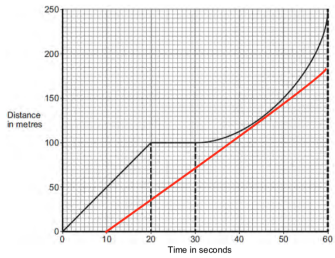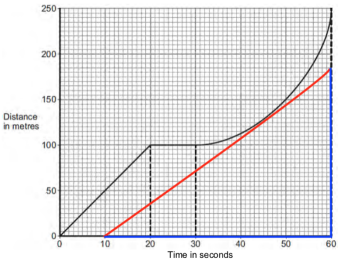Curved Distance-Time Graphs (GCSE Physics)
Curved Distance-Time Graphs
Calculating Speed from a Curved Graph
If a distance-time graph is curved, then the object is changing speed because the gradient is changing. Therefore it can be accelerating (curving up) or decelerating (curving down).
This makes it difficult to work out the speed a certain point. Through the following example, we will see how to do this:
Question: A bus is taking some children to school. The bus has to stop a few times. The figure below shows the distance–time graph for part of the journey.
What is the speed of the bus at 45 seconds? Show clearly on the figure above how you obtained your answer.

Speed is the gradient. Since this is a distance-time graph, the gradient of the graph is still the speed.
1. Find the gradient at 45 seconds.
We are asked to find the speed of the bus at 45 seconds, so we need to find the gradient of the graph at 45 seconds.
2. Draw a tangent at 45 seconds.
At the time 45 seconds on the x axis, find the corresponding y axis value. At this point, draw a tangent to the curve.

3. Find the distance and time.
Using the graph, find values for distance and time from the tangent.
Distance = 185 metres
Time = 60 – 10
Time = 50 seconds

4. Use the gradient equation.
Now that we have values for distance and time, we can use our formula change in y / change in x to find the speed at 45 s.
gradient = change in y / change in x
Gradient = speed
speed = distance / time
Distance / time = 185 / 50
speed = 3.7 m/s
5. Use the gradient equation.
Now that we have values for distance and time, we can use our formula change in y / change in x to find the speed at 45 s.
gradient = change in y / change in x
Gradient = speed
speed = distance / time
Distance / time = 185 / 50
speed = 3.7 m/s
Distance-Time Graphs are visual representations of the distance an object has traveled over a given period of time. These graphs are used to analyze an object’s motion and determine its velocity and acceleration.
A Curved Distance-Time Graph is a type of distance-time graph that represents the non-uniform motion of an object. The curve on the graph represents the change in velocity of the object over time.
The slope of a curved distance-time graph represents the velocity of the object. The steeper the slope, the faster the object is moving. Conversely, a shallower slope means the object is moving slower.
The acceleration of an object can be determined by finding the rate of change of velocity, or the slope of the tangent line to the curve on the distance-time graph. The greater the slope of the tangent line, the greater the acceleration of the object.
Yes, curved distance-time graphs can be used to determine the speed of an object. By finding the slope of the tangent line to the curve, we can determine the velocity of the object at a given time, which is equivalent to its speed.
Curved distance-time graphs are used in various real-life applications, such as analyzing the motion of vehicles, determining the speed of athletes, and analyzing the motion of projectiles. They are also useful in physics experiments, where they are used to determine the motion of objects under various conditions.
The shape of the curved distance-time graph changes with changing acceleration. A curved graph with a positive slope represents a positive acceleration, while a negative slope represents a negative acceleration. The steeper the slope, the greater the acceleration, while a flatter slope represents a smaller acceleration.
It is important to understand curved distance-time graphs because they provide a visual representation of an object’s motion and allow us to analyze its velocity and acceleration. Understanding curved distance-time graphs is a fundamental concept in physics, and is essential for understanding motion and the laws of motion.





Still got a question? Leave a comment
Leave a comment